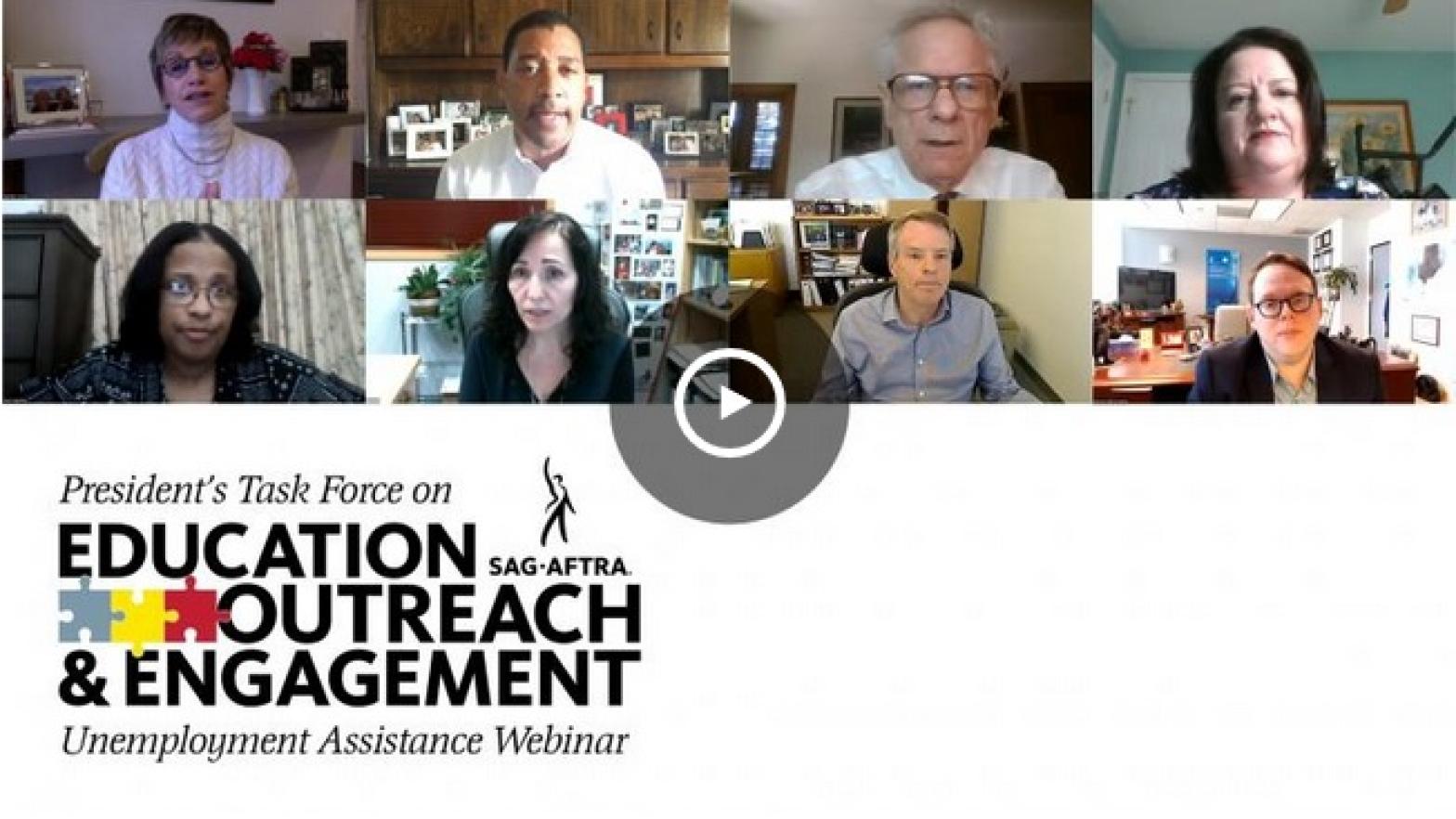
In an effort to better inform members about the federal relief package known as Coronavirus Aid, Relief, and Economic Security (CARES) Act, SAG-AFTRA President Gabrielle Carteris and the President’s Task Force on Education Outreach and Engagement held an unemployment benefit webinar on April 7. Joining the two-hour virtual panel were National Employment Law Project Government Affairs Director Judy Conti; New York State Department of Labor’s Insurance Program Manager Rena Lata and Director of Adjudication & Determination Paul Mason; attorney David Rosenfeld of labor law firm Weinberg, Roger & Rosenfeld; and SAG-AFTRA Counsel Sonja Augustine. Moderating the panel was Chief Operating Officer and General Counsel Duncan Crabtree-Ireland. More than 4,000 members and union leaders attended.
Here are things performers should know about state unemployment laws and the CARES Act’s provisions:
The CARES Act, through the Pandemic Unemployment Assistance program, expands upon state-administered unemployment insurance programs to cover those individuals who do not qualify for traditional unemployment insurance benefits or who have exhausted them.
It is a common misconception that all SAG-AFTRA performers are freelancers who would not qualify for unemployment insurance. If a performer has physically worked in the past 18 months and has received W-2 income from any employer, as many performers do, then they will likely qualify for traditional unemployment benefits. W-2 income could come from any number of jobs, including working under a SAG-AFTRA contract or waiting tables at a restaurant, but keep in mind that if a performer receives enough W-2 income to qualify for traditional state unemployment, the state will likely not consider any other kind of income (e.g., 1099 gig income) for the benefit amount calculation. For performers who operate a loan-out corporation or pay themselves with W-2 income, speak to a tax attorney to best understand how your loan-out is structured and the best way for you to weather this public health crisis.
What’s important to remember is, the CARES Act both offers new benefits and expands benefits to individuals who otherwise would not qualify for unemployment. Specifically, the bill, guarantees an additional $600 a week to all eligible individuals until July 31. Should an individual exhaust state unemployment benefits, they would receive additional coverage for a 13-week period. If a recipient of traditional unemployment benefits exhausts all 39 weeks available to them, they would then be eligible for the Pandemic Unemployment Assistance program.
Still, it’s best to remember that states differ in their processes, benefits and policies.
While the CARES Act offers new benefits and expands benefits to individuals, keep in mind that each state differs in their benefit amounts, how they compile and process applications, and their policies on eligibility and reporting requirements. Be sure review each state’s unemployment benefit website and the application itself thoroughly, and report earnings (W-2, 1099 or otherwise) accurately in the initial application to avoid delayed benefits.
“[Providing your earnings] will make the process go smoother and, if you are ineligible for state insurance, you would automatically be [placed] in the [Pandemic Unemployment Assistance] program,” said Lata.
Panelists also advised that those who have worked in multiple states take time to research the maximum benefits that each state offers and apply for the unemployment insurance that’s best suited to their needs. Some states, on the other hand, want you to apply in each state you received a W2 and do not process combined applications. Access this information on your state unemployment website.
In California, applicants are asked whether they have worked in another state during the relevant application time period. If the answer is “yes,” a link is provided and the applicant must download and fill out the application from the link. Otherwise, the application cannot be processed properly. Fax or mail in the application to the fax number or P.O. Box address at the bottom of the application. During a period of shelter at home, you may want to investigate apps or computer programs that allow you to fax without the need of a fax machine.
Residual payments do play a factor in the amount of aid an applicant receives.
Residual income comes into play in two situations: when applying for benefits and when reporting weekly income once approved.
As residual income is considered W-2 income, those employers have paid unemployment insurance for those earnings, and the state will count this income in calculating one’s weekly benefit amount. The more eligible income one reports when applying for benefits, the higher the benefit amount will be up to the state maximum.
As with unemployment insurance benefits, states differ in how they treat residual income for purposes of weekly reporting. Once a claim is approved and benefits begin, the requirement is to certify that claim on a weekly or biweekly basis, depending on the state’s requirement. While receiving unemployment insurance benefits, all income must be reported (including residuals); however, states have different rules as to how they treat residual payments. For example, California and New Jersey offset the residual amounts received from weekly benefits, but New York does not, and other states have different rules concerning this issue.
Overall, the biggest takeaways from the webinar were to do research on the unemployment insurance benefits your state of residency (or state of work) offers; keep records of all payments, payroll stubs, contracts, etc.; take care that information regarding wages and earnings is accurate and reported accurately; and to document the process, including screenshotting the online application as you fill it out.
View the webinar below. For more information about unemployment assistance in your state, visit our SAG-AFTRA resource here. For frequently asked questions about unemployment assistance, click here. The President’s Task Force on Education Outreach and Engagement will hold additional webinars to address this and other COVID-19-related issues.
The views expressed at this workshop are not intended to imply an endorsement of any individual or company by SAG-AFTRA. The information provided above and through the workshop is given for informational purposes and may not be a suitable substitute for the advice of tax preparer/professional, legal or financial counsel. You should always use good judgment in these matters and should not act or refrain from acting based solely on the information above and provided through the workshop.

Replay of the President's Task Force on Education, Outreach and Engagement webinar on unemployment assistance, held April 7, 2020. Topics include applying for unemployment insurance and getting relief provided by the CARES Act.
News
- Tags:
- News Updates
